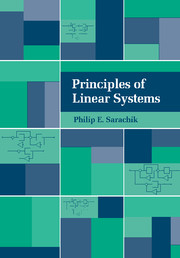Book contents
- Frontmatter
- Contents
- 1 Basic concepts, terms, and definitions
- 2 State equations of finite dimensional linear systems
- 3 Principles of time-domain analysis
- 4 Solution of the dynamic state equations
- 5 Frequency-domain analysis for fixed analog systems: application of the Laplace transform
- 6 The Ƶ-transformation of discrete-time signals
- 7 Frequency-domain analysis of discrete systems and application of Ƶ-transforms
- 8 Controllability and observability of linear systems
- 9 Stability of linear systems
- Appendix Review of matrix theory
- References
- Index
8 - Controllability and observability of linear systems
Published online by Cambridge University Press: 05 June 2012
- Frontmatter
- Contents
- 1 Basic concepts, terms, and definitions
- 2 State equations of finite dimensional linear systems
- 3 Principles of time-domain analysis
- 4 Solution of the dynamic state equations
- 5 Frequency-domain analysis for fixed analog systems: application of the Laplace transform
- 6 The Ƶ-transformation of discrete-time signals
- 7 Frequency-domain analysis of discrete systems and application of Ƶ-transforms
- 8 Controllability and observability of linear systems
- 9 Stability of linear systems
- Appendix Review of matrix theory
- References
- Index
Summary
Introduction and definition of controllability
The concepts of controllability and observability, which were first introduced by Kalman (1960), play an important role in modern system theory. We shall see later in this chapter how they are used to obtain minimal realizations for systems described by sets of differential equations, once any realization is obtained by the methods discussed in Chapter 2. These concepts also appear as necessary conditions for the existence of solutions to many optimal control problems and when studying stability properties of systems. We begin with the concept of controllability.
Definition 8.1A system is called (completely) controllable if for any initial time to, any initial state x(t0) can be transferred to any final state x* (i.e., x(t)=x*) using some input [to, t] over a finite time interval (i.e., t is finite).
Note: In the literature, “completely” is used to denote a system that is controllable for any initial time t0 (as in our definition) as opposed to a system controllable over a specified time interval. There are numerous refinements of this concept, as, for example:
Total controllability if the system is completely controllable over every (or almost every) finite interval.
Strong controllability if the system is controllable from each input terminal.
Output controllability if the system output (rather than state) can be set arbitrarily at some finite time t, by using an appropriate input.
- Type
- Chapter
- Information
- Principles of Linear Systems , pp. 151 - 183Publisher: Cambridge University PressPrint publication year: 1997

